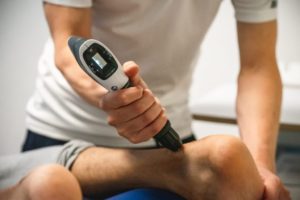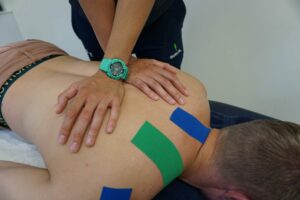Een makkelijk ezelsbruggetje hoe om te gaan met blessures van de weke delen in de acute fase is het acroniem RICE (rust, ijs, compressie, elevatie), in 1978 bedacht door arts Gabe Mirkin.
Echter gaat deze niet in op de subacute en chronische fase van de blessures. In het British Journal of Sports Medicine stond een mooi alternatief! Namelijk: PEACE and LOVE.
Direct na een het ontstaan van de blessure heeft het weefsel vrede nodig:
- P voor ‘’Protect’’ (beschermen)
Ontlast het geblesseerde lichaamsdeel gedurende 1 tot 3 dagen, zodat er optimaal weefselherstel kan optreden. - E voor ‘’Elevate’’ (verhogen)
Verhoog het ledemaat hoger dan het hart, zodat bloed en vocht makkelijk afgevoerd kan worden. - A voor ‘’Avoid anti-inflammatory modalities’’ (vermijd onstekingsremmers)
Ontsteking is een natuurlijke reactie van het lichaam om beschadigd weefsel te herstellen. De ontsteking remmen met behulp van medicijnen kan daarmee het herstel op lange termijn negatief beïnvloeden, vooral wanneer hogere doseringen worden gebruikt. De auteurs zetten hun vraagtekens bij koelen. Hoewel koelen pijnstillend werkt en veel gedaan wordt, is er weinig wetenschappelijk bewijs over de werkzaamheid van koelen. Koelen kan mogelijk het ontstekingsproces verstoren en leiden tot een verstoord weefselherstel. Ook eerder genoemd arts Gabe Mirkin trekt het koelen in twijfel. - C voor ‘’Compress’’ (compressie)
Externe mechanische druk kan worden toegepast doormiddel van taping of verband. Dit helpt het gewricht te beperken in beweging en het oedeem en weefselbloeding te verminderen. - E voor ‘’Educate’’ (educatie)
Voorlichting geven aan patiënten zorgt voor meer kennis over wat er aan de hand is en hoe men moet omgaan met de blessure. Voordelen van een actieve aanpak zijn vaak groter dan een passieve aanpak; beter oefeningen doen dan masseren.
Na een aantal dagen heeft het weefsel liefde nodig:
- L voor Load (belasten)
Een actieve benadering met beweging is beter voor het herstel van de blessure. Activiteiten moeten
worden hervat zodra de symptomen dat toestaan. Optimale belasting zonder verergering van pijn
bevordert de reparatie van het weefsel. - O voor Optimism (optimisme)
Optimistische verwachtingen van de patiënt zijn geassocieerd met betere resultaten en prognose.
Psychologische factoren zoals zoals catastroferen, depressie en angst kunnen een belemmering
vormen voor het herstel. - V voor Vascularisation (vascularisatie = doorbloeding)
Optimistische verwachtingen van de patiënt zijn geassocieerd met betere resultaten en prognose. Psychologische factoren zoals zoals catastroferen, depressie en angst kunnen een belemmering vormen voor het herstel. - V voor Vascularisation (vascularisatie = doorbloeding)
Vroeg starten met mobiliseren en laag tot matig intensieve training (aerobe verbranding) verbeteren de doorbloeding, lichamelijke functie en verminderen de behoefte voor pijnmedicatie bij mensen met blessures. - E voor Exercise (oefenen of trainen)
Er is sterk bewijs voor het gebruik van oefeningen voor de behandeling van bijvoorbeeld enkelverstuikingen. Oefeningen helpen om de mobiliteit, kracht en proprioceptie (gevoel en coördinatie) te herstellen na een blessure. Pijn moet vermeden worden tijdens de herstelfase en moet als leidraad gebruikt worden om de oefeningen te verzwaren, of wel belasten op geleide van
de pijn.
Als u geblesseerd raakt, denk dan aan dit ezelsbruggetje: PEACE and LOVE. U kan natuurlijk ook altijd bij onze sportfysiotherapeut in Rotterdam langsgaan voor advies!







